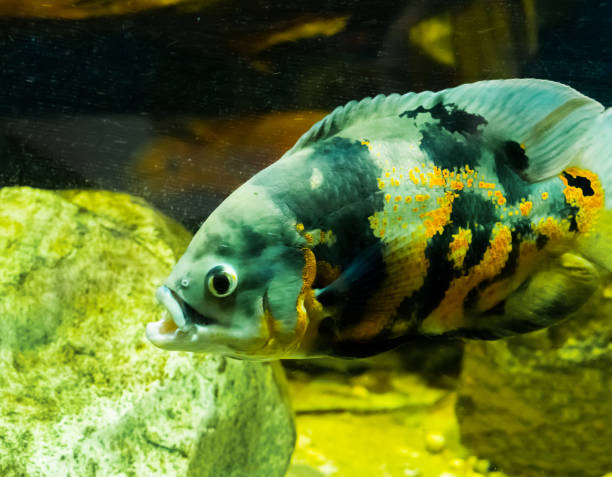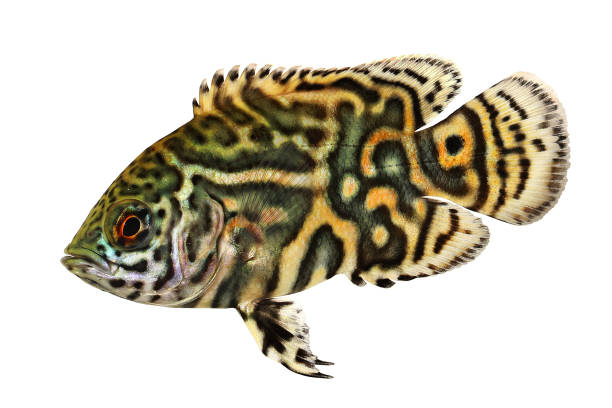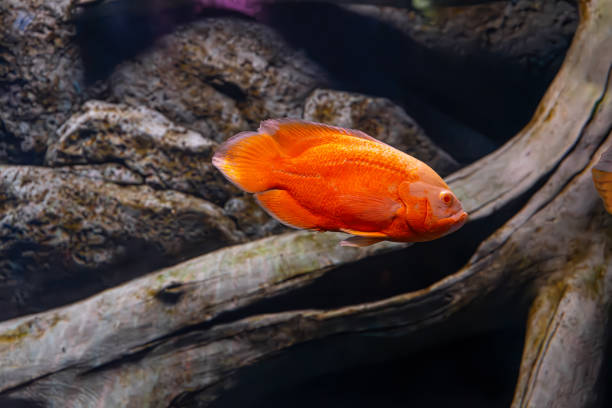Easy tips on breeding and caring for Marble Oscar fish with solutions to common health problems. Learn how to setup your Marble Oscar fish community aquarium without stress.

Introduction to Marble Oscar Fish
Are you an aquarium enthusiast looking for exotic fish breeds to spice up your tank? Have you considered the Marble Oscar Fish but want to know more before finalizing your decision? You’re not wrong to seek knowledge, so here are the answers you need.
Marble Oscar is a beloved aquarium fish species because of their unique appearance. Like many popular aquarium fish, this species has some striking qualities that make it a preferred choice amongst other decorative pets.
This detailed guide shows you why the Marble Oscar fish gained a loving reputation, including its origin, characteristics, care, and health tips.
History and Origin
The Marble Oscar fish history isn’t as old as some other types of Oscar fish, but it’s still worth mentioning.
This species has tropical fish origins because they migrated from the South American basin. But since the early 1900s, this species has become one of the most captivity-bred South American cichlids.
Here are some physical characteristics that make Marble Oscars stand out amongst others.
Physical Characteristics

Marble Oscars are robust despite having an oval and laterally compressed body. They have long, flowing fins extending from the head to their tails and pectoral fins for swimming.
This species grows up to 18 – 24 inches long at maximum length with a unique coloration. The Marble Oscar fish’s appearance is sometimes a mix of white, gray, and black, and other times red-orange.
There are no exact fish patterns, as the coloration varies depending on the fish. However, Marble Oscars share some tropical fish traits with other types of Oscar fish.
Types of Oscar Fish
Although Marble Oscar varieties are the star of this guide, they’re not the only popular cichlids from South America. Other types of Oscar fish include the Red Oscar, Lemon Oscar, and Tiger Oscar, which looks like the Marble Oscar.
Besides the obvious physical differences, you may need more Oscar fish facts to draw more comparisons between the species if you’re unsure of which one to breed.
Check out this table to see the differences at a glance.
| Oscar Type | Coloration | Length | Characteristics | Images |
| Marble Oscar | Marble pattern of white, black and gray mixed with red or orange | 18 – 20 inches | Active, Territorial, Interactive and Aggressive |  |
| Tiger Oscar | Bright Orange/Red and Black stripes | 18 – 20 inches | Active and Territorial |  |
| Red Oscar | Bright Red | 18 – 20 inches | Aggressive and territorial |  |
| Lemon Oscar | Tennis yellow with dark patterns | 18 – 20 inches | Territorial and Interactive (Intelligent) |  |
Ideal Tank Setup For Marble Oscar Fish
Are you ready to build the perfect Marble Oscar fish tank setup? Because you can only get the best out of your pets when you breed them in optimal tank conditions. Here’s what to pay attention to when creating your aquarium habitat design:
Tank Size
Because of the Marble Oscar fish’s length, it’s best to get a large tank that holds atleast 100 gallons of water for one fish. This allows your pets to grow to optimal lengths and have enough space to move without getting territorial and aggressive.
Water Parameters
Ensure your tank water is soft to moderately hard with a pH balance of 6 – 7.5 and no warmer than 74 – 80℉.
Filtration and Aeration
Keep the water clean with a quality filtration system and improve the oxygen flow using an aeration machine.
Substrate and Decoration
Soft substrates with smooth edges are the best types of decor to protect your Marble Oscar’s fins from injury. Other aquatic decor ideas include using artificial but breathable plants, sands, and fine gravels to fuse safety with beauty.
Feeding and Diet


Thankfully, you won’t spend too much money feeding your pets because the Marble Oscar diet is omnivorous. That means they eat meat and plants. You can curate balanced fish nutrition with regular commercial fish food or live and frozen foods.
Some common food types you can add to your Marble Oscar diet are:
- Worms and Insects for stimulation
- Frozen food like bloodworms and brine shrimp as supplements
- Commercial pellets for high protein
For more on feeding your aquatic pets check out The Ultimate Guide to Fish Food: Pros and Cons & Best Choices!
Feeding Frequency
Your Marble Oscar fish doesn’t need to eat too much, even though you can feed it two to three times daily. Always serve portions your pets can finish within 2 to 3 minutes to avoid wastage and potential ammonia poisoning from polluted water.
Health and Common Diseases
Marble Oscar fish face common fish ailments and some special diseases based on their unique features. Here’s how to identify each one, prevent them, and cure them in case your pets get sick.
Ich (White Spots)
White cottony spots on your Marble Oscar fish’s fins and bodies. It’s also grainy like salt when you feel it and is a bacterial infection.
Treatment: Apply copper-based ointments on the affected area and treat the water with medicinal salts for baths.
For more details checkout our article on How to Treat Ich Outbreaks in Your Freshwater Fish!
Hexamita (Hole-in-The-Head)
Deep holes in the center of your Marble Oscar fish’s head that sometimes extend to the eyes. It’s an effect of malnutrition and poor water quality.
Treatment: Ensure your Marble Oscar is feeding on a balanced diet and change the water. Use the correct water parameters, and if the ailment persists, get medication from a certified fish vet.
Fin Rot
A bacterial infection that causes frayed fins with discoloration.
Treatment: Antibacterial Medication and frequent water changes with the correct parameters.
Dropsy
Obesity is caused by overfeeding such that your Marble Oscar fish will struggle to breathe and swim. You’d notice raised scales and bloating. It could also be an infection caused by poor water quality.
Treatment: Fast your fish for a few days and clean the water.
So, you see how easy it is to maintain your Marble Oscar’s health, but it’s also easy to make mistakes. Fish disease prevention is all about ensuring your pets have the best care, from feeding to housing and living conditions.
Breeding Marble Oscar Fish
There are slightly different tank requirements for breeding Marble Oscar fish from the regular parameters used to keep them as pets. You must consider that at birth, Marble Oscar Fish fry at this stage are underdeveloped and needs extra care. So here’s what to do —
This video has been very helpful in identifying the sex of Oscar fish, I highly recommend it:
Tank Setup
You need a 100-gallon tank because there must be enough space for your male and female Marble Oscars to perform their mating rituals. The adult male chases the female and nudges her belly to spawn eggs.
Ensure there’s a spawning mop at the base of the tank beside the smooth rocks and flat surfaces for easy accommodation of the eggs.
Increase the temperature to 80 – 82℉ and pH levels to 6.5 – 7.5.
Oscar Fish Reproduction
At this stage, your female Marble Oscar needs a rich protein-filled diet to nourish her and the eggs. Once she spawns, the eggs cluster on the spawning mop, and the male can fertilize it. The external fertilization makes the eggs sticky, so ensure the water is free of dirt.
Typically, the parent Marble Oscar fish protect their eggs, but it’s also a dangerous stage to leave them around, especially without enough food. If you don’t monitor them closely, the adults may eat their eggs after mistaking them for food.
Marble Oscar Fry
Your Marble Oscar eggs will hatch within 3 – 4 days, after which they’d feed on their yolk sac. Within three days or more, depending on their genetics, the Marble Oscar fry will start free-swimming, and in a week, they’d be ready to join a growth tank.
Separate the larger fry from the smaller ones to prevent predation and introduce infusoria, crushed pellets, or special fry food into their diet.
If you follow these Marble Oscar fish breeding techniques, you’ll get successful fish fry that grow into healthy adults.
Once you’ve completed your breeding process, it’s time to consider compatibility with other Oscar fish and non-Oscar species.
Behavior and Compatibility
Firstly, we’ll look at the Marble Oscar’s behavior and then consider its compatibility with others.
Marble Oscar Behavior
This species is typically territorial, so they can get aggressive in overcrowded tanks or when there’s a food shortage.
Marble Oscars are interactive because of their ability to recognize owners over time. So, don’t be surprised when they appear to welcome you during feeding or water change moments.
Also note that this Oscar variety, unlike others, is very proud, so they don’t like to share their owners’ attention.
Marble Oscar Compatibility

If you’re worried about having an aquarium with community fish, don’t stress. There’s a way around it. Use these fish compatibility tips to curate the perfect tankmates for your Marble Oscar fish.
- Pair your Marble Oscar fish with non-territorial species like catfish and large barbs.
- Keep them with non-fussy fish that won’t struggle for the spotlight with them.
- Don’t place smaller fish in the same tank, as this will trigger predatory behavior in your Marble Oscar fish.
Your goal when curating a community tank is managing fish aggression. You mustn’t put any tank mates that’ll make your pets turn territorial in the same space.
Conclusion
I can’t believe it’s time to say goodbye. I’ve enjoyed chatting with you about Marble Oscar fish care, from feeding to breeding and health tips. Fish-keeping advice isn’t exhaustive, and you need specialized care for Marble Oscars based on their uniqueness.
Before I leave you, here’s a reminder on how to maintain an ideal Marble Oscar fish aquarium.
Always monitor your pets to ensure they’re healthy and not showing signs of stress or discomfort. Also, follow all the aquarium maintenance tips in this guide, including periodic tank cleaning and the use of good filtration systems.
You’re ready for your Oscar fish enjoyment.


